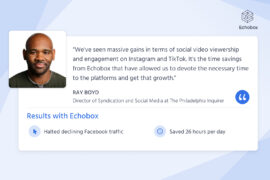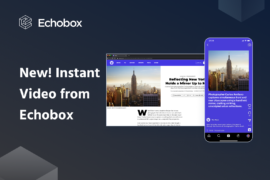For social media managers, figuring out how to get more engagement on Facebook is one of the most important parts of the job. But experimenting with content to increase engagement is often put on the backburner in favor of just getting content posted and ensuring a steady stream, especially when working with a relatively small social media team.
Whether it’s CTR, comments, likes, shares, or any number of potential metrics your business uses to measure the success of your social media approach, making sure that your audience is an active rather than passive consumer of your content means you can develop a sense of brand loyalty that generates repeat custom.
So how do you increase engagement on Facebook? Here are 4 strategies employed by some of the biggest content producers around the world, all Echobox users, taken from some of our case studies.
1: Choosing the right timing matters for visibility and engagement
One of the most important factors in increasing engagement on Facebook is making sure that you share your content at the best possible time to boost visibility. This was a previously under-valued consideration for social media teams, for whom “optimal timing” generally translated as “those times of the day when most people are probably online.” But our data scientists have discovered a Facebook algorithm that assesses not simply when you share posts, but how frequently and in what volume. This algorithm dictates how likely or unlikely your content is to be featured in someone’s Facebook Feed, potentially boosting or penalizing your visibility and engagement significantly.


For many businesses, intelligent automation has proven the perfect solution for beating this algorithm.
The South China Morning Post’s use case mirrors many large brands, a company with a global audience needing to optimize posting and engage users in different time zones. For SCMP’s Social Media Editor Shea Driscoll, using Echobox’s timing optimization and automation is invaluable.
“Maximizing social reach for global audiences requires an appreciation for posting optimization that determines the best times to achieve high levels of engagement,” Driscoll told us. “Echobox’s algorithm and time slot functionality removes one variable from the equation — I don’t have to manually manage time slots, pushing stories back and forth in relation to each other, but instead can just post in a time period I’m comfortable with, and move on.” With this approach SCMP achieved substantial increases in pageviews from Facebook of over 56% and time savings of nearly 4 hours per day.
France’s Le Figaro has gone even further. Head of Social Media Marie Amélie Putallaz was able to fully automate Le Figaro’s Twitter posting, leading to a 59% increase in engagement with the company’s Tweets. This has allowed them to really devote time to Facebook, using Echobox’s streamlined workflow to cross-post to different platforms from the same interface and increase impressions on Facebook by 144% and Facebook engagement by 58%.
2: Create interactivity to increase engagement on Facebook
One of the most obvious and effective ways that businesses can maximize engagement on Facebook is through interactivity. Online polls, Q&As, quizzes and live videos are excellent methods of engaging with consumers. For social media staff engaging directly with the public, interactivity is a great way to foster a sense of community and trust as well as establish a brand’s voice and value proposition. But these high-touch interactions require significant attention and investment of time.
Online polls, Q&As, quizzes and live videos are excellent methods of engaging with consumers.
Adam Silvers, Newsweek’s Deputy US News Director and Senior Digital Strategist, told us that his publication uses intelligent automation to manage day-to-day social media posting, allowing them to concentrate their efforts instead on connecting more meaningfully with their audience via “Twitter polls, interacting with comments, or staying on top of trends happening at large on the platforms, with competitors and with other social media content producers.” On the other hand, Zinet’s Social Media Manager, Laura Sutil Berjón, says her team “prioritize[s] the details that the audience likes, such as creating interactive Stories [on Instagram] in which users can participate.”
Each has its merits relative to the companies’ audience and their specific content offerings, and each is the product of extensive experimentation that requires time and energy. For both Newsweek and Zinet, then, automating routine social posting ensures that their social media teams are able to prioritize high-value, engagement-driving activities, whilst ensuring maximum visibility for each post.

3: Find the right niche for your content
Another of the big challenges social media teams face when it comes to creating engagement with posts is the time it takes to accurately gauge just how well content is performing. Measuring the view and engagement metrics for each article across multiple platforms is a time consuming affair, let alone archiving and surfacing your top-performing material so that it can be reshared again. The end goal is a coherent and well thought out social presence with a defined vision of who you’re targeting with your content, and an understanding of which kinds of content thrive on which platforms.
Grupo Clarín’s Argentinian news channel Todo Noticias (TN) focuses on increasing engagement by ensuring that their content is as targeted as possible to smaller segments of their audience across different platforms. This means getting a firm understanding of not only what works, but why. “We want to focus more on finding specific audiences for different types of content on each platform,” TN’s Social Media Lead Federico Aikawa told us.
We want to focus more on finding specific audiences for different types of content on each platform
Federico Aikawa, Social Media Lead at TN
Aikawa and his team use Echobox’s analytics functionality to easily understand how different content performs on different platforms, enabling them to implement their findings, refining their posting strategy to better tailor their social presence to the behavior of their audience.
4: Tested content produces better engagement on Facebook
For businesses really looking to fine tune their social media performance and increase engagement on Facebook, A/B testing is an invaluable tool. Echobox is the only social media automation tool that can A/B test natively on Facebook. Simply set the A/B test in motion and Echobox’s AI will return results within 15 minutes, automatically sharing the winning variation. Being able to test small variations in layout, tone of voice, length of share message, or any number of subtleties means that social media teams can get an accurate and nuanced understanding of what their audience likes and improve engagement rates.
For The Telegraph, one of Britain’s biggest daily newspapers, A/B testing has become an important component in their social media team’s daily workflow and helped to drive an incredible increase in engagement from Facebook posts of over 205%. But The Telegraph not only optimizes its content with A/B testing, it also secures buy-in from across the business. “We use A/B testing in Echobox when we want to demonstrate the power of a shorter headline, or when we’re trying to help a new reporter/journalist understand what works better for our audience,” says Elise Johnson, The Telegraph’s Head of Social Media.
Echobox helped The Telegraph increase engagement from Facebook posts by over 205%.
Online publication and retailer, Highsnobiety, meanwhile, use A/B testing “all the time,” unless a post requires immediate publication. A/B testing was a central part of a posting strategy that Miranda Unwin, Highsnobiety’s Social Media Editor, employed to boost traffic from Facebook by nearly 60% whilst saving more than 10 hours every week. It’s “very helpful for honing posts to suit your audience,” she told us. “It has provided a lot of helpful and sometimes surprising insights as to what our audience prefers.”
Save time and grow engagement from Facebook
Getting more engagement from your Facebook posts needn’t be a mystifying task.
These content creators are all using different engagement methods and succeeding, but their efforts rely on 2 main pillars: a deep understanding of their audience, and a solid grasp of their own unique USP. Developing these takes time, though, and without saving considerable hours throughout the week by automating different aspects of their own social media workflow, it would be a tricky task to fit all of the necessary thinking and iterating into an already crammed day.
For a large group of businesses, repetitive hours spent planning, posting and recycling content have been clawed back. Marketing and editorial teams around the world automate their content distribution and achieve incredible time savings with Echobox.
“With a manual social media publishing tool like SocialFlow, Sprout or Sprinklr,” Adam Silvers told us, “it takes a lot of time out of the day to post new content, recycle a ton of content, and everything else you’re supposed to do in an 8-hour workday.” Silvers estimated that in total, the manual curation, posting and management process would take 90% of his time — time that could be spent on higher value, more creative work. By automating social media posting, businesses all over the world are able to dedicate more time to driving greater engagement from Facebook and other social platforms.
Silvers perhaps summarized it best: “Echobox has freed up members of our relatively small team to focus on other engagement opportunities with our audience. I view Echobox as another team member in that it performs a function, it does it quite well, and it gives time back to other members of the team.”



